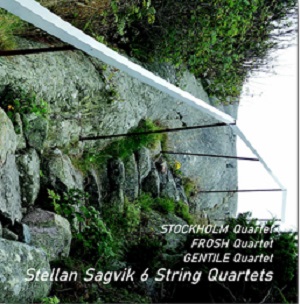
Stellan Sagvik (b. 1952)
String Quartet No 1 (1971)
String Quartet No 2 (1972)
String Quartet No 3 (1973)
String Quartet No 4 (1990)
String Quartet No 5 (1994)
String Quartet No 6 (1993/2021)
Stockholm Quartet (1-3); Frosch Quartet (4-5); Gentile Quartet (6)
rec. 1993, Swedish Radio (1-3); 2022, Sofia (4-5); Flemingsberg (6)
Nosag Records CD2246 [2 CDs: 108]
The composer Stellan Sagvik merits a few words of introduction. He was born in Örebro, Sweden in 1952 and undertook studies at both Stockholm University and the city’s Royal Swedish Academy of Music. He maintains a very active career with many strings to his bow. In addition to composing, he’s a singer, conductor and, since 1989, runs the record company Nosag Records, whose aim is to release significant contemporary music. His compositional oeuvre embraces opera, three symphonies, concertos, vocal and choral works, piano and chamber music, the latter of which includes the six string quartets featured on this release.
The six quartets span the years 1971 to 2021 and cover a wide range of emotions. You’ll discover overflowing lyricism, reflective intimacy, lavish romantic gestures, a dramatic quotient and, at times, unbridled energy. Three ensembles are harnessed for the performances: the Stockholm Quartet (1-3), Frosch Quartet (4-5) and Gentile Quartet (6).
Sagvik was a teenager when he penned his String Quartet No 1 in 1971 and he relates how this music was the first he wrote without using a piano. The work took flight whilst sitting outside on a tree stump, no doubt inspired by the surrounding forest landscape. He cast it in four movements. It begins tortuously and troubled. A more lightweight second movement lightens the strain somewhat. Then comes a slow movement which made me think of the composer contemplating with wonder the beauty that surrounds him. The fourth movement starts hesitantly before becoming more animated. The two-movement Second Quartet came a year later in 1972. The opener is capricious and playful, with the second movement acerbic and static with brief flaming interjections.
In 1974, Sagvik resorted back to the four-movement structure for his Third Quartet. The first movement enters with a hustle and bustle tumult, eventually becoming more settled and reflective. A conversational second movement follows, which leads into a spiky third. String/bow effects add a touch of colour to the animated finale.
By 1990 the composer had developed a more compositionally advanced style when he tackled his fourth work in the genre. It’s a single movement and bears the title ‘ESEMBE variations on a Warszaw theme’. Glissandi and harmonics are harnessed for effect. The music paints a less than glowing picture of the city during the hot summer of 1990. I’ll quote what the composer says: ”The city stinks from foul smelling Polski Fiats with bad quality petrol, people stink (also we visitors) after showering in the definitely sewer passed ‘freshwater’ running from the taps (brushing teeth made me throw up)”.
The Fifth Quartet, dated 1994, was written for the Frosch Quartet. The title ‘Ylanin Logoty’ is an anagram of the musicians’ names, and each of the four players is spotlighted in each of the four movements. In the opening movement, the first violin plays a leading role, tenanted in the upper reaches for much of the time. The second violin occupies a similar position in the following movement. There’s some skilful interweaving of the viola into the convoluted textures of the third movement. Finally, the cello takes centre stage with the other performers offering a light seasoning of paprika.
At 39 minutes, the Sixth Quartet is a much more substantial score than its predecessors. It was originally written as a chamber opera, “a couple quarreling about nothingness at a restaurant table”. The title of the Quartet is ‘Mo’olelo’ meaning ‘story’. The four movements also adopt Hawaiian titles: ‘Ono’ (six or sex in Swedish), ‘La’au lapa’au’ (medicine), ‘Make’ (death) and ‘Hau’oli’ (glad). These give clues or pointers to the plot of the score. The spiky pizzicatos of the first movement portray an argumentative scene. Relentless undercurrents also underpin the second movement. ‘Death’ is painted in dark sombre hues, whilst the final movement offers something a little more sanguine.
These well recorded performances are given engaging readings. In the accompanying liner, the composer shares his personal reflections on each of the works. For those adventurous enough to explore, I’d say go for it, you won’t be disappointed.
Stephen Greenbank
Previous review: Rob Barnett (June 2023)
Availability: Nosag Records

















